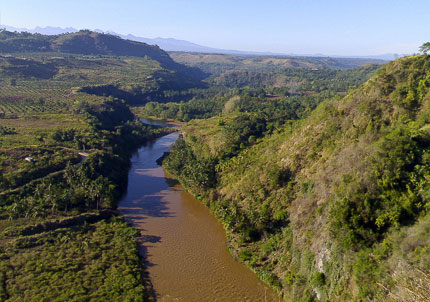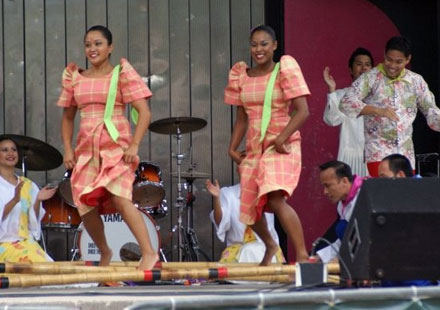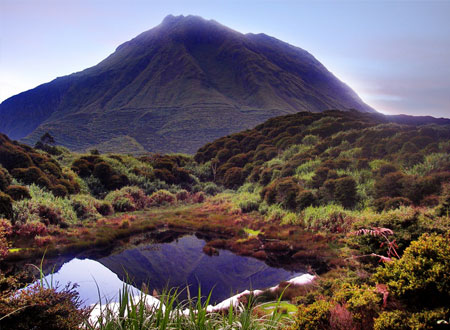Philippines
Country statistics

Land area: 115,124 sq miles (298,171 sq km)
Total area: 115,830 sq miles (300,000 sq km)
Population (2011 est.): 103,775,002 (growth rate: 1.87%); birth rate: 24.98/1000; infant mortality rate: 18.75/1000; life expectancy: 71.94
Capital City: Manila
Monetary unit: Peso
Languages: Filipino (based on Tagalog), English (both official); eight major dialects: Tagalog, Cebuano, Ilocano, Hiligaynon or Ilonggo, Bicol, Waray, Pampango, and Pangasinense
Ethnicity/race: Tagalog 28.1%, Cebuano 13.1%, Ilocano 9%, Bisaya/Binisaya 7.6%, Hiligaynon Ilonggo 7.5%, Bikol 6%, Waray 3.4%, other 25.3% (2000)
Religions: Roman Catholic 81%, Evangelical 3%, Iglesia ni Kristo 2%, Aglipayan 2%, other Christian 5%, Islam 5% (2000)
Country introduction

The Philippines is an archipelago located in South-east Asia and is affectionately referred to as the 'Pearl of the Orient Seas'. It is made up of 7,107 islands (volcanic in origin) that are scattered like pearls in the Pacific Ocean. Other bodies of water that surround the archipelago are the South China Sea on the west and north and the Celebes Sea on the south.
The islands are divided into three major regions: Luzon, the largest island in the north; the Visayas, an island group in the center; and Mindanao, the largest island in the south.
The topography of the bigger islands, particularly Luzon and Mindanao, is characterized by alluvial plains, narrow valleys, rolling hills and high mountains. The highest mountains are found in Mindanao and Luzon, with the altitudes varying from 1,790 to 3,144 m (5,872 to 10,315 ft). Most of the smaller islands are mountainous in the interior, surrounded by narrow strips of discontinuous flat lowlands which constitute the coastal rims. The shorelines of both large and small islands are irregular.
The Philippines consists of volcanic islands, including active volcanoes, with mostly mountainous interiors surrounded by flat lowlands and alluvial plains of varying widths along the coasts. The elevation ranges from sea level to the highest point of Mount Apo on Mindanao Island, at 2,954 m (9,691 ft) above sea level.
The longest river is the Cagayan on Luzon, about 350 km (217 miles) in length. Other principal rivers on Luzon include the Abra, Bicol, Chico, and Pampanga. The Pasig River is only about 25 km (15 miles) in length but serves as the main waterway, flowing between Laguna de Bay, the largest freshwater lake in the Philippines, through metropolitan Manila to Manila Bay. Principal rivers on Mindanao include the Mindanao River (known as the Pulangi River in its upper reaches), and the Agusan. The St. Paul River on Palawan is an 8 km (4 miles) long underground river.
The culture

Philippine culture is very diverse, derived mainly from Malaysian and Indonesian roots. Despite their strong ties to those countries, the Filipinos generated their own individual culture, even before the first Europeans landed on the Islands.
There are over 100 dialects throughout the Philippines 7000 islands, and each one retains its own aspects of the Philippine culture, supplemented by influences from America, China, India, and Saudi Arabia. However Filipino culture remains uniquely Filipino. Linguistically, the nation is amazingly diverse with more than 170 languages. The most common Dialect is known as Tagalog which has borrowed quite a number of Spanish words from the days when Spain was a ruling entity in the Islands.
Religion is a very important part of the Philippine culture, and to emphasise this point many fiestas and festivals are held throughout the year, celebrating the patron Saint of that town or city. Colourful street parades, fireworks, church services, and lots of dancing and music make a real spectacle for the tourist to witness. The Philippines is predominantly a Roman Catholic nation, however the Southern Islands are influenced by the Muslim faith.
Philippine Cuisine has evolved over several centuries, influenced by East Asian Indian, Malay, Chinese, Spanish and American cooking. Filipinos traditionally eat three main meals a day - almusal (breakfast), tanghalian (lunch), and hapunan (dinner) plus an afternoon snack called merienda. Dishes range from a simple meal of fried fish and rice to rich paellas and cocidos. Popular dishes include lechón (whole roasted pig), longanis (native sausage), tapa (beef jerky), torta (omelette), adobo (chicken and/or pork braised in garlic), kaldereta (goat in tomato stew), mechado (beef or pork cooked in tomato sauce, pochero (beef in bananas and tomato sauce), afritada (chicken cooked in tomato sauce and vegetables), kare-kare (oxtail and vegetables cooked in peanut sauce), crispy pata (deep-fried pig's foot), hamonado (pork sweetened in pineapple sauce), sinigang (pork, fish, or shrimp in tamarind stew), pancit (stir-fried noodles), lumpia (fresh or fried spring rolls).
Music and dancing is very important in the Philippine culture. Everywhere there is live music to watch, to listen to and even for visitors to take part in. The Philippine people love to share the stage with any willing performers. The early music of the Philippines featured a mixture of indigenous, Islamic and a variety of Asian sounds. Spanish settlers and natives played a variety of musical instruments including, guitar, ukulele, violin, trumpets and drums. They performed songs and dances to celebrate festive occasions. Modern day Philippine music features several styles. Most music genres are contemporary such as Filipino rock, hip hop and other musical styles. Philippine folk dances include the Tinikling and Cariñosa. The Tinikling dance, or the Bamboo dance, derives its name from bird Tikling and the dance imitates the birds movement as it hops from one rice paddy to another.
Attractions & landmarks

As an archipelago composed of 7,107 islands, the Philippines offers countless of attractions to see, such as the famous white sand beaches of Boracay, big shopping centers of Metro Manila, rice terraces of Ifugao, diving sites of Palawan, lush forests of Bohol, heritage houses in Vigan, and the cultural attractions of Manila. Most of the tropical islands in the Philippines offers natural attractions such as forests, mountains, beaches and coral coral reefs which all serves as tourist attractions.
Metro Manila, the national capital region of the country, is known for being one of the best shopping destinations in Asia. It's wide collection of shopping centers offers a range of local and international shops. Numerous shopping malls can be found around the metropolis especially on the business and financial districts of Ortigas Center and Bonifacio Global City. High-end shopping centers are mostly located at the Ayala Center. Despite the rise of modern shopping centers, traditional Filipino shopping areas still remains around the metropolis.
Located just approximately 315 km (196 miles) south of Manila is Boracay, it is known for it's white sand beaches and has been a favorite island destination for local and foreign visitors. Aside from it's white sand beaches, Boracay is also known for being a popular destination for relaxation, tranquility and for an exciting nightlife.
Mindanao, the southernmost island of the Philippines is home to the country's tallest mountain, Mount Apo. The mountain features a wide range of flora and fauna and is home to over 272 bird species, 111 of which are endemic to the area. Mount Apo is also home to the country's national bird, the Philippine Eagle. Mount Apo is a popular destination for hiking and mountain activities.